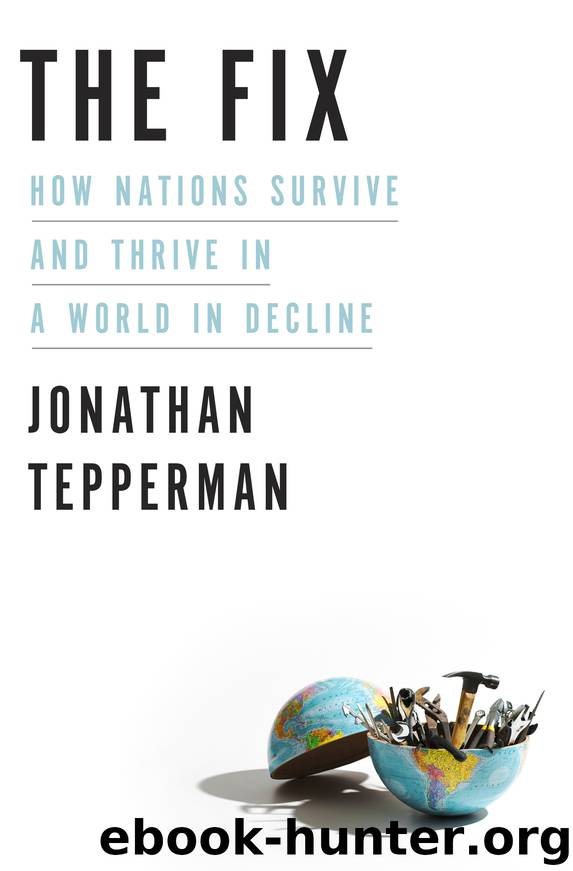The Fix by Jonathan Tepperman

Author:Jonathan Tepperman [Tepperman, Jonathan]
Language: eng
Format: epub, mobi
Publisher: Crown/Archetype
Published: 2016-09-19T23:00:00+00:00
At virtually the same time that Botswana and Singapore were struggling to survive their difficult births, another newborn nation found itself in similar straits.
Strictly speaking, Korea wasn’t new, of course; the country had existed in various forms for centuries, ever since it was first unified by King Munmu in AD 668. But the Empire of Japan had invaded in 1910 and then spent the next thirty-five years trying to grind away every trace of indigenous culture. Though liberation finally arrived with VJ Day in 1945, Korea’s occupation was soon replaced by division: the peninsula was split along the 38th parallel between the Soviets, who occupied the North, and the Americans, who held the South. The two superpowers swiftly set up two new states in their respective zones of influence. And in June 1950 those two states went to war.
All civil conflicts are bitter, but Korea’s was especially so. In three years, it destroyed much of what the Japanese had left behind. By the time the US-led Eighth Army retook Seoul from North Korean and Chinese troops midway through the war, South Korea’s capital had been reduced to a smoking ruin. Of the city’s 1.5 million prewar inhabitants, only 200,000 remained; nationwide, a tenth of the population was dead. The South’s infrastructure and economy were similarly devastated. It’s thought that half of all houses on the peninsula were leveled, and Gregg Brazinsky, a historian at George Washington University, estimates that nine hundred factories, more than half the country’s freight trucks and locomotives, and more than $3 billion in property were demolished.
This was not fertile ground on which to build a new country.
Yet in the decades since, South Korea has managed to transcend its unhappy origins and thrive beyond anyone’s expectations. Unlike Botswana, say, which is wealthy by African standards but still just middle-income, South Korea has vaulted through the economic ranks to become one of the richest countries on the planet. A state that was poorer than Bolivia, Ghana, or Iraq in 1961 is now the world’s seventh-largest exporter, boasts the world’s thirteenth-biggest GDP, and rivals Italy and New Zealand in per capita wealth. Visit Seoul today, and you’ll find few signs of the country’s grim past. Futuristic skyscrapers stand where bombed-out buildings once smoldered. Well-heeled young people stroll through ritzy neighborhoods like Gangnam (yup, that Gangnam) and ride the city’s gleaming, WiFi-enabled subways, fiddling with outsize, next-generation smartphones and phablets. They even look different than their parents did: thanks to huge improvements in the local diet, the average South Korean male now stands 3.5 inches taller than his predecessors did a mere thirty years ago.
But even more remarkable is how South Korea accomplished all this: by expanding its economy at a healthy clip for more than five decades. Such longevity is exceedingly rare. Most countries are sprinters, not marathon runners. While plenty of them have managed to boost themselves out of abject poverty in the last half century, very few—just thirteen, in fact—have figured out how to maintain their escape velocity.
Download
This site does not store any files on its server. We only index and link to content provided by other sites. Please contact the content providers to delete copyright contents if any and email us, we'll remove relevant links or contents immediately.
| Arms Control | Diplomacy |
| Security | Trades & Tariffs |
| Treaties | African |
| Asian | Australian & Oceanian |
| Canadian | Caribbean & Latin American |
| European | Middle Eastern |
| Russian & Former Soviet Union |
The Secret History by Donna Tartt(16622)
The Social Justice Warrior Handbook by Lisa De Pasquale(11489)
Thirteen Reasons Why by Jay Asher(7788)
This Is How You Lose Her by Junot Diaz(5770)
Weapons of Math Destruction by Cathy O'Neil(5036)
Zero to One by Peter Thiel(4824)
The Myth of the Strong Leader by Archie Brown(4789)
Promise Me, Dad by Joe Biden(4447)
Beartown by Fredrik Backman(4415)
Stone's Rules by Roger Stone(4415)
How Democracies Die by Steven Levitsky & Daniel Ziblatt(4398)
The Fire Next Time by James Baldwin(4342)
100 Deadly Skills by Clint Emerson(4076)
A Higher Loyalty: Truth, Lies, and Leadership by James Comey(4032)
Rise and Kill First by Ronen Bergman(4012)
The David Icke Guide to the Global Conspiracy (and how to end it) by David Icke(3881)
The Farm by Tom Rob Smith(3872)
Secrecy World by Jake Bernstein(3782)
The Doomsday Machine by Daniel Ellsberg(3730)
